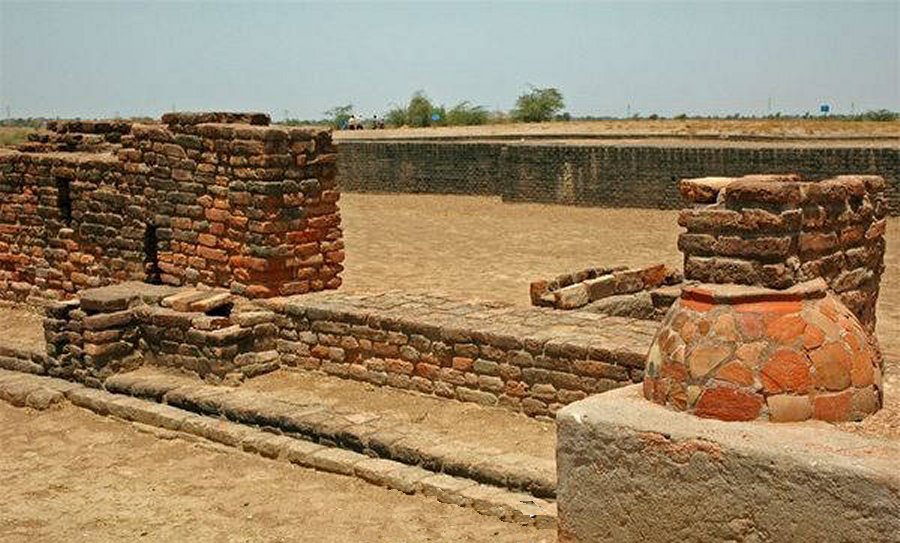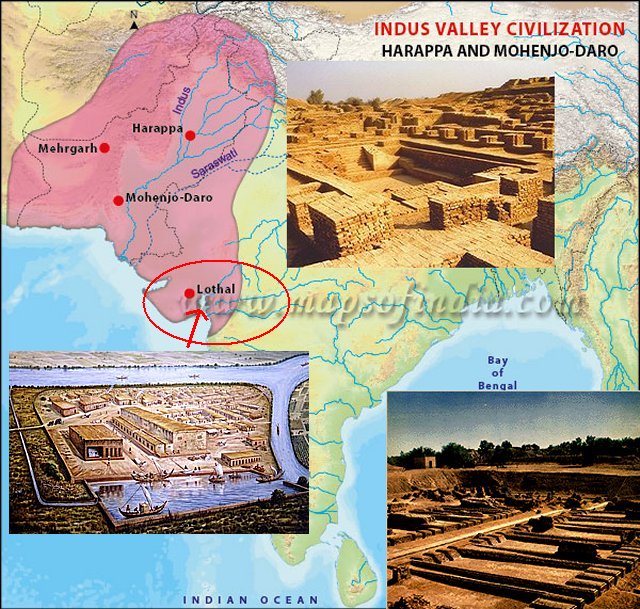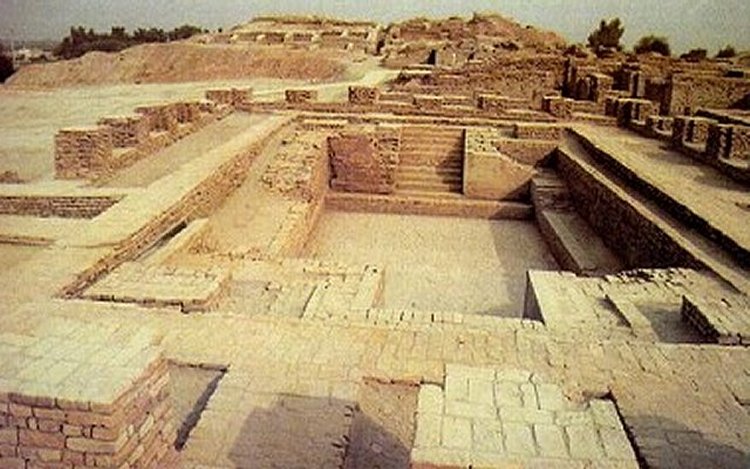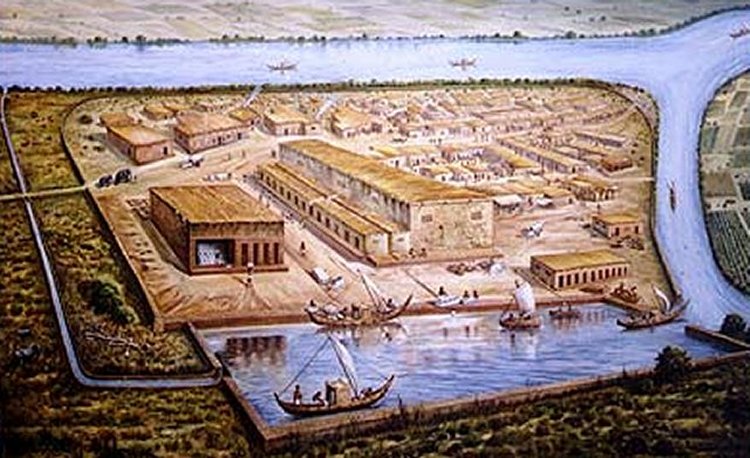Lothal – ‘City of Dead’ – One Of The Most Prominent Ancient Places In Danger To Be Forgotten
A. Sutherland - AncientPages.com - Throughout history, abandoned ancient places with fantastic history have always fascinated people. Unfortunately, many of these places are now forgotten, neglected, or destroyed.
Lothal, one of the most prominent cities of the ancient Indus Valley Civilization, located in the Bhal region of the modern state of Gujarat, in the western part of India, is just one such example.
About 80km southwest of Ahmedabad, the city that stood at this archaeological site 4500 years ago, was one of the most important of the Indus Valley civilization, which is now Pakistan's. Excavations have revealed the world's oldest known artificial dock connected to an ancient course of the Sabarmati River.
Lothal also has more. Other features include the acropolis, the lower town, the bead factory, the warehouses, and the drainage system.
Loth and thal, which in Gujarati means 'the mound of the dead.' The city was inhabited during 3700 BCE and was a thriving trading port. The excavation was started from 13 February 1955 to 19 May 1960 by the Archaeological Survey of India (ASI) to unearth ancient cities.
Archaeologists believe that the city was a part of a central river system on the old trade route from Sindh to Saurashtra in Gujarat. Excavations here have offered the most significant number of antiquities in the archaeology of modern India.
Lothal, which means 'The City of Dead,' is an old city dating back to the 4,400year-old Harappan civilization and one of the few known ports on an ocean.
Lothal has initially been the site for the lustrous Red Ware culture, associated with the post-Rigvedic Vedic civilization and named for its mica-related pottery.
The people of Lothal worshipped a fire god, which could be the horned deity depicted on ancient seals.
The city that developed as the most important port and a center of the bead industry, gems, and valuable ornaments flourished until 1900 BC. These products reached the far corners of West Asia and Africa.
The massive dockyard, which was the world's earliest known, had 37 meters from east to west and nearly 22 meters from north to south. It made Lothal famous. The dock was probably the most outstanding work of maritime architecture before the birth of Christ. It was the earliest known dock found in the world, equipped to berth and service ships.
It has been speculated that Lothal engineers studied tidal movements and their effects on brick-built structures since the walls were constructed of kiln-burnt bricks. This knowledge also enabled them to select Lothal's location in the first place, as the Gulf of Khambhat has the highest tidal strength, and ships can be sluiced through flow tides in the river tributaries or creeks.
Modern oceanographers have observed that the Harappans must have possessed excellent knowledge relating to tides to build such a dock on the ever-shifting course of the Sabarmati. Their knowledge must have also included exemplary hydrography and maritime engineering. It is awe-inspiring because these technologies were used 4000 years ago.
The town was divided into blocks of approx two meter-high (approx 6 ft) platforms of kiln baked and dried bricks, each consisting of 20–30 houses of thick mud and brick walls. The dockyard's location was away from the main river to avoid the deposition of silt.
The engineers built a trapezoidal structure with north-south arms of 21.8 meters (71.5 ft) and east-west components of 37 meters (121 ft).
The basin could have served as an irrigation tank, for the estimated original dimensions of the "dock" are not large enough, by modern standards, to house ships and conduct much traffic.
It connected the city to an ancient course of the Sabarmati river on the trade route between Harappan cities in Sindh and the peninsula of Saurashtra when the surrounding Kutch desert of today was a part of the Arabian Sea.
Surrounded by a massive brick wall, which was probably used for flood protection, Lothal was safe. The southeastern quadrant takes the form of a great platform of brick with earth filling, rising to a height of about 13 feet (4 meters). It was built a series of other smaller platforms with intersecting air channels, reminiscent of the granary at Mohenjo-daro, with overall dimensions of about 159 by 139 feet (48 by 42 meters).
Then, a great flood resulted in the gradual decline of Lothal.
While there is still no sure reason for the decline of the city, archaeological evidence gathered by the Archaeological Survey of India appears to point to natural catastrophes, mainly floods and storms, as the source of Lothal's downfall. The worst consequence was the shift in the river's course, cutting off access to the ships and dock.
Now, the city's remnants are being obliterated. However, the ancient site still attracts visitors, particularly school and college students. Still, no guards protect the ancient ruins, and there are no qualified guides to show the visitor around Lothal.
Tourists trample the structure with little concern for its fragility, and it is common to witness people stealing archaeological remains from the site. Lothal's cemetery is no longer accessible because of wild growth on the approach. The cemetery houses and two skeletons were found during excavations at the site, carried out between 1955 and 1962.
The site is overrun by weeds, adding to the general air of neglect and chaos.
According to ASI officials, 'shortage of funds has lead to staff inadequacy, which has affected even routine maintenance tasks like clearing of weeds. Now, the gateman of the museum has to run to the historical Lothal dock to caution visitors against moving on the precarious structure.'
Money problems prevent officials from carrying out further excavations.
Written by – A. Sutherland AncientPages.com Staff Writer
Copyright © AncientPages.com All rights reserved. This material may not be published, broadcast, rewritten or redistributed in whole or part without the express written permission of AncientPages.com
Expand for references
More From Ancient Pages
-
 Katana ‘Soul Of The Samurai’ – Most Famous Japanese Sword With Long Tradition
Ancient History Facts | Apr 12, 2018
Katana ‘Soul Of The Samurai’ – Most Famous Japanese Sword With Long Tradition
Ancient History Facts | Apr 12, 2018 -
 Fearsome Sekhmet: Lion-Headed Egyptian Goddess And Sister Of Ptah
Egyptian Mythology | May 13, 2020
Fearsome Sekhmet: Lion-Headed Egyptian Goddess And Sister Of Ptah
Egyptian Mythology | May 13, 2020 -
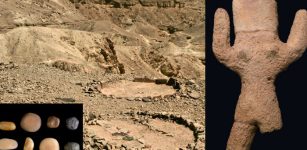 Ancient Artifacts Used In Magical Rituals To Ward Off The Evil Eye Found Next To The Pilgrimage Road
Archaeology | Sep 11, 2023
Ancient Artifacts Used In Magical Rituals To Ward Off The Evil Eye Found Next To The Pilgrimage Road
Archaeology | Sep 11, 2023 -
 Thousands Of Sacred ‘Images’ With Unknown Signs Hidden In A Monastery Could Be World’s Oldest Alphabet
Ancient Mysteries | Jun 9, 2021
Thousands Of Sacred ‘Images’ With Unknown Signs Hidden In A Monastery Could Be World’s Oldest Alphabet
Ancient Mysteries | Jun 9, 2021 -
 Beautiful Ancient Viking Jewelry Made By Skilled Craftsmen
Artifacts | Dec 29, 2015
Beautiful Ancient Viking Jewelry Made By Skilled Craftsmen
Artifacts | Dec 29, 2015 -
 What Was An Aztec Confession?
Ancient History Facts | Jul 25, 2017
What Was An Aztec Confession?
Ancient History Facts | Jul 25, 2017 -
 3,500-Year-Old Tomb Of Egyptian Goldsmith Discovered
Archaeology | Sep 10, 2017
3,500-Year-Old Tomb Of Egyptian Goldsmith Discovered
Archaeology | Sep 10, 2017 -
 Freemasons Secrets – American Democracy Is Part Of An Ancient Universal Plan – Egyptian Temple And Legendary Expedition Hold The Clues – Part 2
Ancient Mysteries | Jul 13, 2018
Freemasons Secrets – American Democracy Is Part Of An Ancient Universal Plan – Egyptian Temple And Legendary Expedition Hold The Clues – Part 2
Ancient Mysteries | Jul 13, 2018 -
 Pazzi Conspiracy – Failed Murder Attempt On Lorenzo de’ Medici Made Him Even More Powerful And Threw Renaissance Florence Into Chaos
Featured Stories | Feb 14, 2025
Pazzi Conspiracy – Failed Murder Attempt On Lorenzo de’ Medici Made Him Even More Powerful And Threw Renaissance Florence Into Chaos
Featured Stories | Feb 14, 2025 -
 Giants Of The Jurassic Seas Were Twice The Size Of A Killer Whale – New Study
Fossils | May 11, 2023
Giants Of The Jurassic Seas Were Twice The Size Of A Killer Whale – New Study
Fossils | May 11, 2023 -
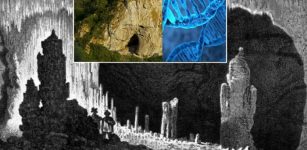 Neanderthals’ History Retrieved From Cave Sediments In Siberia And Spain – New Method
Archaeology | Apr 19, 2021
Neanderthals’ History Retrieved From Cave Sediments In Siberia And Spain – New Method
Archaeology | Apr 19, 2021 -
 How Large Was The ‘Giant’ Dunkleosteus Terrelli – Prehistoric King Of The Oceans?
News | Apr 10, 2023
How Large Was The ‘Giant’ Dunkleosteus Terrelli – Prehistoric King Of The Oceans?
News | Apr 10, 2023 -
 Unique Ornamented Golden Bronze Age Belt Discovered Near Opava, Czech Republic
Artifacts | Oct 28, 2022
Unique Ornamented Golden Bronze Age Belt Discovered Near Opava, Czech Republic
Artifacts | Oct 28, 2022 -
 Strange Case Of A Victim Who Solved Her Own Murder – Unusual Powers Of The Human Mind
Featured Stories | Feb 15, 2019
Strange Case Of A Victim Who Solved Her Own Murder – Unusual Powers Of The Human Mind
Featured Stories | Feb 15, 2019 -
 2,700-Year-Old Ceramic Sculpture Of Goddess Found In Aegean Sea
Archaeology | Feb 28, 2017
2,700-Year-Old Ceramic Sculpture Of Goddess Found In Aegean Sea
Archaeology | Feb 28, 2017 -
 How Did A Piece Of An ‘Epic’ Viking Sword End Up In The Netherlands?
Vikings | Dec 4, 2024
How Did A Piece Of An ‘Epic’ Viking Sword End Up In The Netherlands?
Vikings | Dec 4, 2024 -
 Ancient Secrets Of Sophisticated Jama-Coaque People
Civilizations | Sep 27, 2016
Ancient Secrets Of Sophisticated Jama-Coaque People
Civilizations | Sep 27, 2016 -
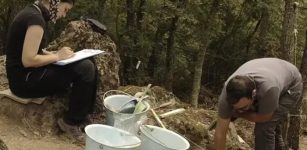 Paleolithic Workshop Unearthed In The İnkaya Cave In The Turkish Western Province Of Çanakkale
Archaeology | Oct 29, 2022
Paleolithic Workshop Unearthed In The İnkaya Cave In The Turkish Western Province Of Çanakkale
Archaeology | Oct 29, 2022 -
 Incredible Ancient Extinct World Of Unknown Organisms Discovered
Evolution | Jun 8, 2023
Incredible Ancient Extinct World Of Unknown Organisms Discovered
Evolution | Jun 8, 2023 -
 Mysterious Skull Cult At Göbekli Tepe – Ancestor Worship Or Trophies Of Dead Enemies?
Archaeology | Jul 25, 2017
Mysterious Skull Cult At Göbekli Tepe – Ancestor Worship Or Trophies Of Dead Enemies?
Archaeology | Jul 25, 2017

